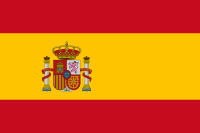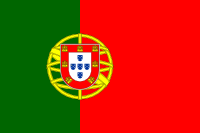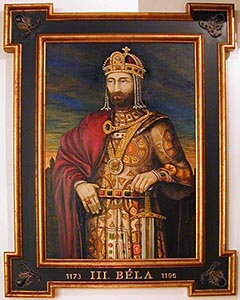On my first day out with my new X-TERRA 705 I found this thin copper coin in an old field on the outskirts of a small Eastern European hamlet. I was hunting in an old farm field along a stream, and found nothing for an hour. Then, just as the sun was setting I hit this small, very thin coin. At first I was not sure what it was, because the features that I could see appeared to be Byzantine, not European. However, my friend quickly ID it correctly as a Hungarian Coin. The coin is called an "AE (copper) Scyphate Follis" from Hungary’s Arpad dynasty, minted in the late 1100's. Name: Bracteate.jpg Views: 203 Size: 263.0 KB ID: 101076 The obverse legend reads + SANCTA-MARIA and shows the Virgin Mary enthroned holding lys scepter in right hand, holding Christ child wrapped in swathing bands in left. The reverse reads R_EX BELA-R_EX STS and shows king Béla on the left and his deceased brother King Stephan III (1162-1172) , in Byzantine style, both holding scepters in right hand across shoulder and a globus cruciger in left. King Béla III (c. 1148 – 23 April 1196) was King of Hungary and Croatia. He was educated in the court of the Byzantine Emperor Manuel I, who was planning to ensure his succession in the Byzantine Empire till the birth of his own son. This may explain why the coin takes on a very distinct Byzantine style. King Béla III was one of the most powerful rulers of Hungary and he was also one of the most wealthy monarchs of Europe of his age: his annual revenue was the equivalent of 23 tons of pure silver. This exceeded the income of the French king (estimated at 17 tons) and was double the receipts of the English Crown. He is entombed in Matthias Church, in Budapest. For medieval history buffs.. here's a lot more detail. This is an excerpt from Stephen Sisa's excellent history of Hungary "The Spirit of Hungary : A Panorama of Hungarian History and Culture".
Peter - Virginia, USA
Béla III, the "Byzantine" King”, by Stephen Sisa.
If Byzantium ever had the opportunity to bring medieval Hungary into its fold, it was during the sixty years following King Kálmán's death in 1116. One after another weak kings and aspirants to the throne eagerly curried Byzantium's favor, seeking its help in either putting them or keeping them on the throne. Curiously, it was the Byzantine Emperor Manuel, a grandson of the Hungarian king Saint László through his mother Piroska, who made an all-out effort to absorb Hungary as a vassal state of Greece. Dreaming of re-establishing the glory of ancient Rome, he planned to include Hungary in his domain first, basing his claim on his relationship to the Árpád dynasty. During the second half of the 12th century, he launched no fewer than ten attacks on Hungary in twenty-two years, and supported several contenders against István III (1162-1172). Paradoxically, the man who ultimately averted this danger was Béla, Manuel's own "adopted son" and prospective heir, who, in an exciting political drama with a surprise ending, became not the Emperor of Greece, but one of the greatest kings in Hungary's history. Béla Becomes Alexios After several unsuccessful attempts to unite Hungary with Greece by force, Emperor Manuel suddenly decided to change tactics: He would subdue the coveted kingdom through family ties. In 1163 Manuel invited King István III's younger brother Béla to the Imperial Court, promising to betroth him to his daughter, making him his successor. The Emperor evidently believed that a prince of the House of Árpád would have no difficulty in claiming the Hungarian throne when a vacancy arose, even while wearing the Greek Imperial Crown. In such a case. he thought, the lands from the Euphrates River to the Lajta River on the Austro-Hungarian border would be ruled by one king.. To this end, when Béla arrived at Manuel's Court, he was given the name Alexios to replace his "barbarian" Magyar name. (Béla is a typical Magyar first name with no equivalent in other languages). Béla, alias Alexios, was treated by the Imperial Court as the heir apparent to both the Hungarian and the Byzantine thrones. Several years later, upon the unexpected birth of a son by his second wife, Manuel recanted. There was no longer any need for an adopted son to inherit his throne. Béla - turned - Alexios suddenly found himself demoted. To make things worse, Manuel also broke off his daughter's engagement to the Hungarian prince, completing Béla's fall from status as a favorite son into that of a tolerated alien. Béla's situation, however, was not as bad as it first seemed. During the years spent at the Imperial Court he has adopted the Greek lifestyle and felt himself quite at home - without, however, forgetting his Hungarian roots. His was in an ambiguous position: not quite a Greek, but not a Hungarian in its former sense either. The far-sighted Manuel asked Alexios to stay at his Court as a welcome guest until the Hungarian throne became vacant. They did not have to wait long, because István III died in 1172. The Prince, thanking the Emperor for his benevolent hospitality and promising him eternal loyalty, set off for Hungary accompanied by Byzantine troops. He became the crowned king of his native land that same year. When Manuel heard the news, he must have rubbed his hands in self-congratulation for having gained a vassal state. What a mistake! What a misjudgment of character! The "Rebirth" of Béla Once Béla III became crowned king he never again used the name Alexios. His years in Byzantium had been well spent. He observed how efficiently organized the Greek Empire was. Administration, finances, the army and diplomacy were part of a smoothly running machine controlled by the emperor. Internal and external affairs were coordinated. This foreign world was rich in customs and institutions, far ahead of his native country. To King Béla the adoption of some of these institutions were imperative if Hungary was to catch up with the more progressive European nations. Béla had great reforms in mind, but once on the Hungarian throne his expectations turned into great disappointments. If he sought unanimous affection, he did not get it, not even from his own family. The reason? Many held that he had become "Byzantinized" in Greece. His own mother regarded him as a stranger, since she would have preferred that her younger son Géza, whom she had educated, had become king. Church leaders were not enthusiastic about him because of a rumor that Béla and his French wife, Anne of Antioch, had been converted to the Eastern Orthodox faith. The mere fact that he had returned accompanied by Greek troops aroused suspicions that his loyalty was divided between Hungary and Byzantium. It took a long time for Béla to consolidate his situation - and he paid heavily for it. He banished his mother to Greece where she spent the rest of her life in a cloister. He imprisoned his younger brother Géza for a period of twelve years. The priests refused to support him until he furnished evidence of being a true son of the Catholic Church. Toward Byzantium he applied the Greeks' own weapon, the art of dissimulation, which he had learned while living at the Imperial Court. This enabled him to fend off Manuel's attempts to make Hungary a Greek vassal state, while skillfully managing to maintain cordial relations with the Greek Emperor, toward whom he felt gratitude and affection. While Manuel lived, Béla made no offensive moves against Byzantium, and even sent him an army in his war against the Turks. When Manuel died, however, Béla hastened to re-unite Sirmium and Dalmatia with the Hungarian Kingdom, executing a contingency plan which lay ready in his drawer for this re-conquest. These provinces had been wrested from Hungary by Manuel decades before. Otherwise, Béla never aspired for the laurels of war. He even insisted, in self-mockery, that he was too much of a coward to fight a war. In reality, he was the brightest European king of his century and laid the foundations of a Hungarian Empire during his reign which lasted from 1172 to 1196. "Civil Rights" in Hungary After re-establishing order and authority, Béla organized the Royal Chancellery, which was to preserve a record of every matter that came before the king, so that royal decrees would not pass into oblivion. Persons who received estates obtained a written deed which enabled them and their heirs to prove and defend their rights. This was a giant step in the evolution of civil law and civil rights in Hungary. The Chancellery was also instrumental, in an indirect way, in spreading literacy. A deed or document was of little value to its owner unless he could read it All complaints and requests had to be submitted in writing to proper authorities. Thus, the presence of at least one literate person was mandatory in every community and in every office handling these matters. In the villages, the people most qualified were usually the priests, who became very busy men in Béla's time until the establishment of schools spread literacy among the population. The French Connection On Béla's initiative, hundreds of Hungarian scholars and students were sent to foreign centers of learning and, upon their return, were placed in key positions. Lukács Bánfi, the Archbishop of Esztergom and an important political figure as well, had been educated in Paris. The King's unnamed notary, known as "Master P." or Anonymus, had likewise been educated in Paris. His History of the Hungarians (Gesta Hungarorum) describes in Latin the origin of the Magyars and their settlement in the Carpathian Basin. This work - one of the earliest histories of Hungary - is preserved to this day. In spreading civilization in Hungary, the ideal Béla chose to emulate was France. He was bound to France through family ties when in 1186 after his wife's death he married Margaret Capet, daughter of Louis VII of France. By this time, Hungary was well on the way to becoming a prosperous country under excellent administration. Béla himself shared in the country's wealth, which he spent prudently. Before his marriage he sent a detailed statement of his fortune and finances to the King of France. According to contemporary records, his annual income totaled 241,000 silver marks, an income equal to that of the kings of France and England! His lifestyle was in keeping with his position. Adopting the Greek Imperial Court as his model, Béla ruled in splendor. His Court attracted many foreigners and, after his second marriage, chiefly the French. The most beneficial of his French connections turned out to be the settling of the Cistercian monks into Hungary. This order is known to devote itself mainly to teaching and preaching, but in Béla's days they were chiefly occupied with agriculture. Some of the monks were the dedicated sons of French aristocratic families who considered it a religious challenge to strengthen their own character by tackling the hardest of problems. Their efforts to turn rough, wooded and marshy regions into model farms, for instance, attracted people from even the remotest districts to learn their agricultural techniques. The Rise of Hungary's Prestige The developments in farming contributed to Hungary's remarkable industrial and commercial growth, making it a link in the chain of international trade joining the great markets of the East and West. German, French and Italian tradesmen began to settle in the cities, introducing new handicrafts and opening up foreign markets for raw materials. Thanks to the policy inaugurated by Béla III, Hungary was to become the most important agricultural country of central Europe. Béla, in spite of his predilection for peace, had to conduct several wars. The re-conquest of Dalmatia after Emanuel's death brought Hungary into a short, victorious conflict against the Venetian Republic. Then, he turned his attention to Byzantium, from which he took back Nándorfehérvár (Belgrade). He was involved in an almost "traditional" war in Halics (Galicia) but it was a conflict of minor significance. The King took a keen interest in the events in the Holy Land. His father-in-law, the King of France, and the King of England and the German Emperor all tried in vain to recover the Holy Land from the infidels. Perhaps encouraged by the Queen, who was a zealous supporter of the crusades, Béla decided to join the next expedition. But he became ill during his preparations, and worrying that he would not recover, he ordered his younger son, Andrew, to go to the Holy Land. When Béla died on April 23, 1196, his legacy was a prosperous and powerful state, whose new leader would be the equal of the German Emperor, the head of Western Christianity. Béla was a king with a unique background, and a unique list of achievements. There is one other "unique" thing about him: his grave. Not a single tomb of the thirty-five kings of Hungary who reigned during the 500 years between Saint István and the battle of Mohács (1526) had ever been discovered until 1848. In that year, workmen uncovered several marble coffins under the Episcopal residence at Székesfehérvár. Further excavations at the site revealed the remains of a cathedral erected by Saint István and destroyed by the Turks. Until its destruction, this cathedral had been the burial place of the Kings of Hungary. However, among the coffins found there only one could be positively identified as a king's tomb. It was that of King Béla III and his first wife, Queen Anne. Archaeologists found the king wearing a silver crown and holding a crusader's baton in his hand, with a ring on his finger bearing an Arabian inscription. Now, the remains of Béla III and his Queen rest in the Matthias Church in Buda, under a marble monument: a unique memorial to a unique king. He was the Empire Builder whose genius finished what Saint István had begun. A few descriptive paragraphs in the foregoing chapters have been drawn from "A History of Hungary" by Imre Lukinich. Simphin Marshall Ltd., London. 1937. Since Saint István's time Hungarian kings were buried in a great basilica named after the Virgin Mary in Fehérvár (today's Székesfehérvár), the ancient capital of Hungary. However few o the royal remains have stayed intact. Saint István, after death, rested in a white marble coffin in the basilica for decades, but in 1242 King Béla IV moved his remains to Dalmatia in an effort to save them from marauding Mongols. Later Saint István's right hand was recovered in Raguza. and in 1777 was brought home to become an object of veneration. Prince Saint Imre, King Kálmán, Béla II, László II, István III, Béla III, László III, Charles Robert, Louis the Great, King Matthias and Lajos II all were buried in this same church. For a while, their bones rested in peace. and even received the respects of Sultan Suleiman when the Turks captured Fehérvár (The Turks did, however, strip the tombs of royal jewels and insignia). Then. in 1601 the church was demolished by an explosion. Still, the tombs themselves remained intact under-ground. Rubble from the ruined basilica was taken little by little for building other churches, until /811, when the site of the old basilica became completely leveled. In 1848 workers installing drainpipes in Fehérvár hit a coffin of red marble. Investigation revealed the remains of King Béla III and his wife. Anne Chatillon, with all their regalia intact. Although four more tombs were found, excavations for the rest of the royal tombs began in earnest only in 1862. The tombs of Saint István's family, King Kálmán, Louis the Great,. Charles Robert,. King Matthias and Lajos II were among those found,. minus their jewels and regalia. Due to an unfortunate misjudgment, the royal bones were intermingled upon their recovery. and put into several boxes without identification.. Only the skeletons of Béla III and his wife were identified and saved intact, later to be moved to their present resting place in the Matthias Coronation Church in Buda.





















